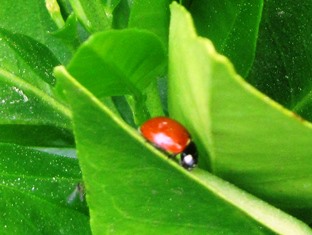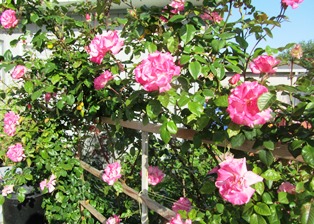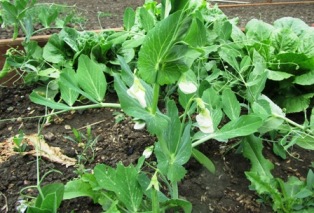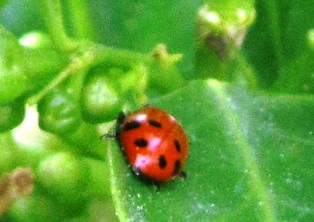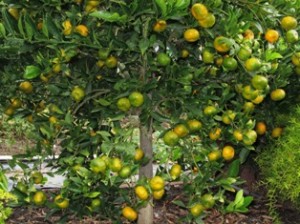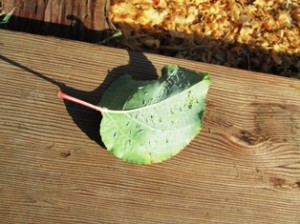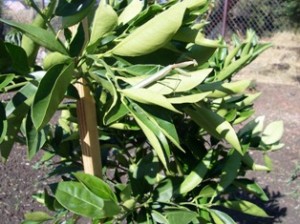Caring for Your Backyard Fruit Trees
The dormant period between winter solstice and the bare-root season of late winter/early spring provides a great opportunity to evaluate a fruit tree’s health. Although trees should be checked throughout each season, the dormant period is a great time to take stock of problems and initiate remedial action before the trees break bud.
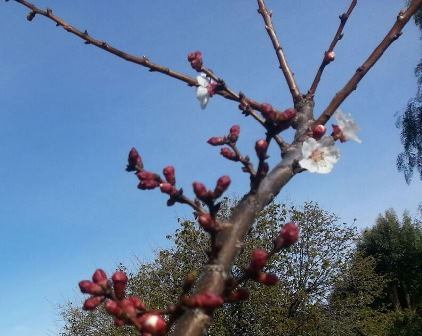
Cherry trees, in particular, can be infected with powdery mildew, root rot, aphids, fruit flies, bacterial canker, and fungal leaf spot
APHIDS
Pests can survive in the crevices of fruit tree bark or any infected leaves on the ground. If your apple trees, for example, were infested with aphids or scale last season and were left untreated, it is likely you’ll have the problems again this spring if the problem is left untreated.
There are a few natural ways to deal with aphids that suck sap on the underside of leaves. Try spraying with an organic neem oil (made from the seeds of the neem tree) that makes feeding or moving by the aphids impossible, causing death to the pests.
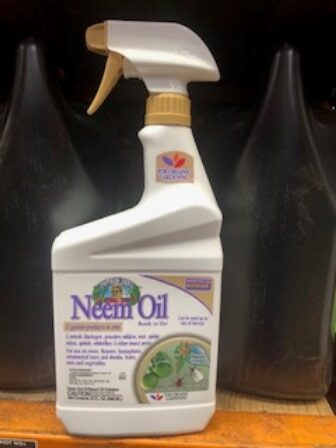
treatment for aphids and mites and can
be used on roses, fruits, and vegetables
An effective homemade treatment is to mix up a spray of 3 teaspoons of soap in a gallon of water. The pests die when they lack food. Spraying them off the tree deprives them of their food source–sap. Another option is to purchase and release ladybugs, natural predators of aphids. A third option is to plant alyssum at the base of your tree. The alyssum plants attract hover flies, a beneficial pest that’s a voracious eater of aphids.
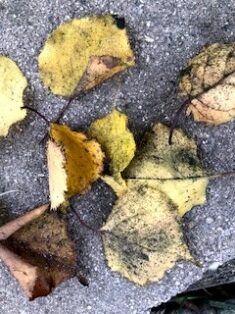
on through autumn
LEAF CURL
Peach leaf curl doesn’t just infect peaches. It can also affect almonds, pears, plums, and nectarines. At its most basic level, leaf curl is a stress of the tree caused by the fungus, Taphrina deformans.
Infected tree leaves become deformed. The leaves develop bulges that look like red blisters and the leaf edges turn inward. Green leaf color becomes yellow.
The fungal spores overwinter on the twigs. When the weather is warm and the outside air is humid, the fungal infection rapidly spreads, especially as buds swell and open. The fungus enters leaf tissue and causes hypertrophy (swelling and distortion of the leaves). The spores develop and lodge in the buds and cracks and crevices. These need to be eradicated in the fall. When leaves drop, remove them and put them into garbage, never in your compost pile.
During an outbreak of leaf curl, gardeners can pick off infected leaves, but you don’t want to denude the tree. The most common remedy is spraying with a lime-sulfer or fixed copper fungicide in late autumn and again before the buds form in spring. However, fungicides and insecticides are toxic to bees. Check with your local garden center for recommendations of organic, non-toxic products used in your area.
Remember with any pruning to rinse your pruning shears in 70% rubbing alcohol, bleach, or other garden cleaning disinfectant formulated to remove any bacteria and fungus to prevent infecting other trees in your backyard garden or orchard.
POWDERY MILDEW
Powdery mildew is a fungal disease that infects over 10,000 plants, according to the University of Minnesota, including roses, peonies, ornamental grasses, and backyard fruit trees. The disease affects a tree’s leaves, buds, flowers, and stems.
Characterized by gray or white patches, powdery mildew is not difficult to detect. To treat powdery mildew, prune back affected parts of the tree and dispose of the cuttings. Improve air circulation to benefit remaining fruit trees (or plants that might be growing too close together).
A foliar spray made of one gallon of water, one tablespoon of baking soda, and a teaspoon of dish soap can be an effective treatment of powdery mildew if applied to all affected areas. Spray and wipe off the the area with a paper towel.
If you enjoy reading about gardening and other country living topics, check out my series of cozy mysteries. Each of the novels in the series is packed with delicious recipes, tips for keeping chickens and bees, and insights into growing heirloom plants. Along with my nonfiction health, wellness, spirituality, and travel books, the Henny Penny Farmette mysteries are available online and everywhere books are sold. –Meera Lester

The Murder of a Queen Bee, and A Hive of Homicides.
Plant Dahlias and Canna Lilies Now for Dazzling Summer Color
Love the tropical foliage and brilliant color of dahlia and Canna lily blooms? Plant them now through April if you live in Zones 8 through 11. Long prized as cut flowers for bouquets, dahlias and Canna lilies do not fail to dazzle also when grouped in flowerbeds alone or with other summer blooming plants.
Indigenous to Central Mexico, dahlias are herbaceous, leafy plants that offer blooms in a wide assortment of colors (except blue and black). Bloom size ranges from a couple of inches across to roughly a foot wide (the largest size is known as “dinner-plate”). Tall varieties need staking and all types can benefit from dead-heading when blooms are spent.
Dahlia roots are actually tubers and do best when planted in moist, well-drained, loamy soil. If growing them in areas where there is frost, dig and store the tubers in a cool, dry (and frost-free) place in the fall for re-planting the next year. In extreme climates like the high desert, dahlias benefit from several inches of mulch covering the bed.
The main pests of dahlias are slugs, snails, earwigs, leaf hoppers, and aphids. Powdery mildew and gray mold can also infect the plant.
Canna lilies, like dahlias, are herbaceous summer-blooming plants that come in a wide variety of colors. Indigenous to sub-tropical areas of North and South America, Cannas can be grown as perennials in zones 7 through 11, according to the U.S. Department of Agriculture. In other zones with more extreme climates, mulch the plants two to four inches deep or lift the rhizomes (roots) and store them in dry peat moss in a cool, dry place until ready to replant.
Plant rhizomes of tall Canna lilies at the back of the flowerbed (or at the front of the bed if the plants are dwarf) in three to six inches of rich, well-drained soil. Position so that the eyes are facing up. Pests include slugs, snails, Canna leaf-rollers, and Japanese beetles. Aphids can spread canna viruses that can cause leaf streaking and bloom disfigurement. The plants are heavy feeders so will need a good organic fertilizer when they begin to look ratty and two to four inches of water each week.
Use tall dahlias and Canna lilies at the back of your flowerbed and add mid-size blooming plants in the middle and dwarf or low growing bedding plants with lots of color at the front to create a spectacular garden area this summer. If you live in a relatively frost-free zone, your dahlias and Canna lilies will spring back to life and carry on with colorful displays amid tropical foliage for years to come.
__________________________________________________________________________________
If you enjoy reading about gardening and the natural world, check out my series of cozy mysteries that include information on growing heirloom plants and keeping chickens and bees. Also see my self-help empowerment and well-being books. All are available online and in bookstores everywhere.

The Henny Penny Farmette series of cozy mysteries–lots of delicious recipes and information for country living
CLICK ON THE LINK to see more.
Have You Planned Your Garden Yet?
Ladybugs and honeybees occasionally meet on the same leaf when both forage for food. The ladybugs dine on aphids while the honeybees seek the sweet nectar of blossoms; orange, tangerine, and lime trees are favorites.
The bug and bee traffic has been steadily increasing now that showers and warm weather have triggered blossoms opening on the fruit and citrus trees around the farmette.
Spring doesn’t officially begin until March 20, but with the weather forecasters predicting upper 70’s Fahrenheit later this week and nighttime temperatures in the 50’s, it is time to consider options for your garden. Many DIY centers are already offering vegetable seedlings, herbs, and berries for planting. Some have markedly discounted their bare-root fruit trees and roses.
I’ve already planted seeds in flats for germination and scattered flower seed (collected from last summer’s flower garden) around prepared beds. When the outside temperatures start to climb, I’ll be rewarded with blooms from nasturtiums, petunias, zinnias, and sunflowers.
The climbing roses are already past the red-leaf stage and are producing the first flush of blooms for spring. The wisteria vines have plump pods ready to unfurl with gorgeous tracts of purple blossoms. And the first green tips of leaves are beginning to sprout on my apples even as the early peaches and apricots already have fruit forming.
This time of year holds the promise of new beginnings, and you see that in every step you take in a garden. Because I prefer to grow plants from varieties of heirloom, open-pollinated seed, I save it from the best specimens grown in the previous season. Of course, some plants freely re-seed themselves. That’s why I now find lettuce and onions and even sweet peas coming up in expected places on the property.
Have you figured out what veggies, flowers, fruits, and berries you’ll plant and grow in your garden this year? If not, now’s a good time to get started. For ideas, check out, http://www.organicgardening.com/learn-and-grow/plan-beautiful-vegetable-garden.
If you prefer, as I do, the non-GMO and organic seeds, there are many excellent sources for them. For heirloom and rare seed, check out http://www.rareseeds.com/store/vegetables/. Also see, http://www.victoryseeds.com/aboutus.html and http://www.anniesheirloomseeds.com/
The Farmette Welcomes a Proliferation of Ladybugs
Ladybugs, of late, are proliferating all over the Henny Penny Farmette and on my neighbors’ properties as well. On Sunday afternoon, the young daughters of a neighbor and I spent a lovely hour plucking ladybugs from the grass, placing them upon our hands, and watching them zip up and down our arms.
Ladybugs are beneficial to the gardens. It’s been estimated that during its life that lasts about a year, the average ladybug will consume 5,000 aphids, those soft-body pests whose larvae that dine on tender, young plant shoots.
Of the thousands of species of ladybugs in the world, only about 175 are found in California. By far, the Convergent Lady Beetle is most common and highly beneficial to California gardens.
The various varieties of ladybugs and other beneficial insects can keep in check populations of harmful pests so gardeners won’t have to resort to using insecticides and pesticides. A healthy, strong ecosystem is always best for organic gardens.
Female ladybugs are often larger than their male counterparts, depending on the species. Some have spots and some don’t. Their color isn’t limited to just red and orange, but can include a host of other hues. To learn more about ladybugs, see http://www.everything-ladybug.com/ladybug-facts.html.
A daily stroll around the farmette that includes a ladybug sighting tends to make me smile. I might even be heard whispering words of welcome. With the ladybugs here, I feel reassured that my organic fruits and vegetables are a little safer from the dreaded aphids.
Keeping a Garden Ecosystem in Balance
A healthy ecosystem, whether in a forest or a garden, stays in balance in part because of its “grazers” and “predators.” The grazers can range in size from a large plant-eating animal like a cow to a tiny aphid, and predators share this size range, too. Consider for example, a tiger (predator) in a wild, natural environment dining on an antelope (a grazer) or tiny ladybug (a predator for grazing aphids) in a rose garden.
A lush, healthy garden will have an underlying healthy ecosystem. If your garden plants are being devoured by pests, you might want to introduce more of the pests’ natural enemies. For example, if your roses are infested with one or more of the 200 different types of aphids, buy lacewings.
One lacewing larva can destroy roughly 200 pests (and pest eggs) for as long as two or three weeks. The adult lacewings do not kill insects (they suck nectar and pollen), but their larvae will inject venom into aphids and then suck out the the plant grazers’ body fluids, which destroys those pests. Adult lacewings will stick around if there are sources of pollen, nectar, and honeydew. They are beneficial to a garden ecosystem because the lacewing larvae feed on spider mites, mealybugs, leafhoppers, thripes, and other unwanted plant grazers.
Take a stroll around your garden on a regular basis. Take note of its ecosystem. Create a healthy garden using organic products when possible. Remember that plants cycle through seasons. There may be periods of the year when your plants seem to be more infested than at other times. Practice tolerance if an infestation is mild. Let nature run its course. If the balance is right in your ecosystem, the predators will take care of the grazers.
Pest Control
A rain storm threatens to blow in over the Northern California coastline but here in the shadow of Mount Diablo, the wind is warm, the sky is blue, and the birds and bullfrogs are singing. I have to grout the kitchen counter backsplash and otherwise prepare the farmette for Thanksgiving, a goal I set at the beginning of the year. But this morning, I feel inspired to stroll through the garden to inspect my still-blooming roses, pluck and devour a strawberry or a ripe fig, or sample the mandarin oranges from the heavily laden tree. What could possibly ruin the start of such a beautiful day?
Pests, that’s what! I found colonies of aphids on the underside of the leaves still hanging onto the young apricot trees. Scrutinizing the underside of the leaves on the orange tree, I found ants inching up the trunk. That suggests to me there is a food source in the tree for those ants. So now I have deal with pests before starting the kitchen grout work.
Pests and gardens go together. I might not be able to eliminate the pests, but at least I can control them. I like an integrated control approach to dealing with pests. For example, I try not to plant all of one type of plant or tree in one area–that’s just inviting trouble in the form of pests that attack that type of plant. Also, I’ve included different varieties of the same type of plant like an apricot and a apricot/plum hybrid called an aprium tree. When I see leaves on my roses or trees with aphids, I pick the leaves off and put them in a bag (not the compost pile) to dispose of them.
My heart feels lighter when I spot a praying mantis in the garden for these amazing little creatures love to eat moths, flies, grasshoppers, crickets, and other annoying little pests. In fact, I like to introduce populations of helpful insects to compete with pest population. Green lacewings or “aphid lions” devour aphids, lots of them, but they’ll also dine on spider mites and mealybugs. Ladybugs (more correctly, “Ladybird Beetles”) are also a favorite of mine since they eat aphids, mites, and scale insects.
Spiders trap mites and pesky insects in their webs and I feel fortunate to have many in my garden. Occasionally I see those shiny black beetles known as Ground Beetles but don’t handle them because they stink. However, they can serve as a veritable hungry army against cutworms and the larvae of other pests in the garden.
I don’t like poisons or insecticides, but I will mix soap with water to spray some plants. Companion planting, or the growing of plants in close proximity for both plants’ mutual benefit, such as enhancing soil nutrients and discouraging harmful pests, is another way I control pests. So while I would love to enjoy my early morning, I think I’d better get to work on the pest problem now. The grouting can wait. There are still two days before Thanksgiving.
 Facebook
Facebook Goodreads
Goodreads LinkedIn
LinkedIn Meera Lester
Meera Lester Twitter
Twitter









